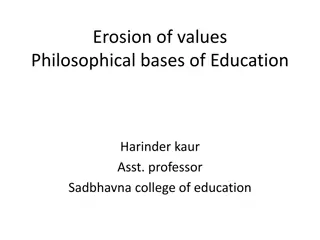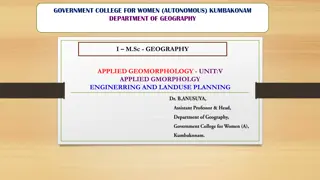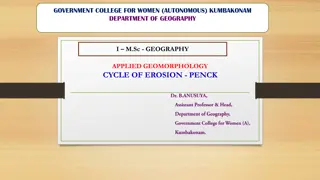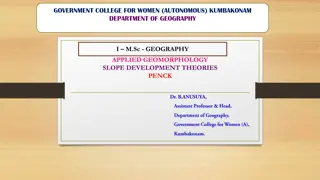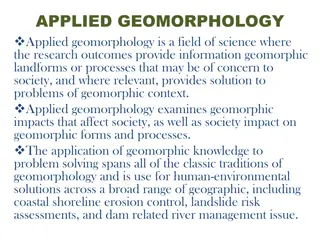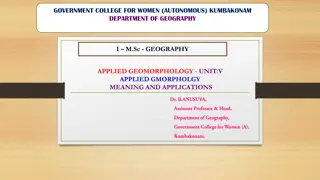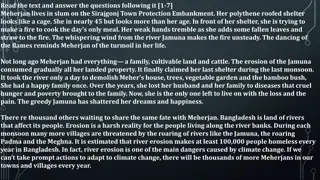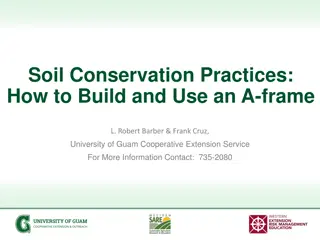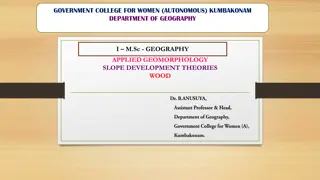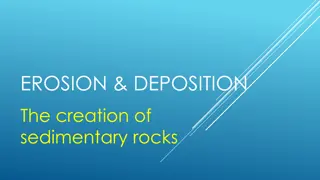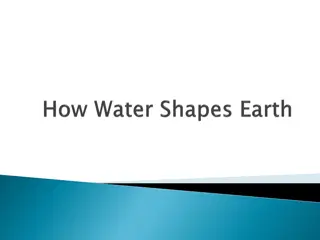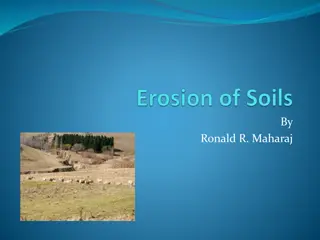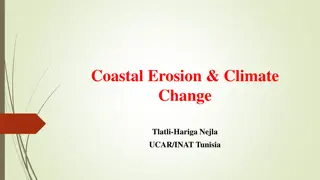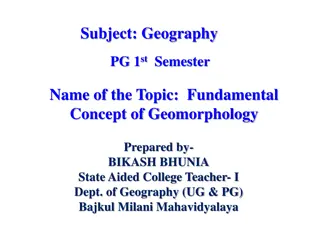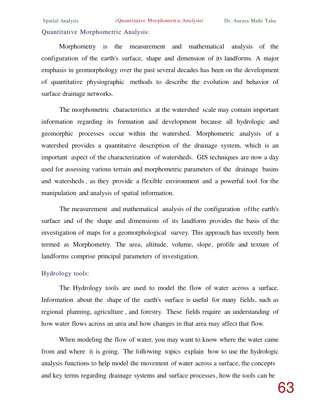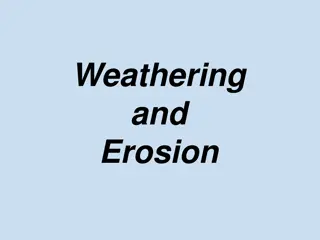Understanding the Cycle of Erosion: Applied Geomorphology Perspective
The Cycle of Erosion model, developed by Davis in the 1880s, explores the process of landmass upliftment, river erosion, and landscape transformation. The Normal Cycle of Erosion focuses on fluvial processes as the primary geomorphic agent, leading to the formation of peneplains. This cycle progresses through stages of youth, maturity, and old age, influencing both landscapes and river valleys.
Download Presentation

Please find below an Image/Link to download the presentation.
The content on the website is provided AS IS for your information and personal use only. It may not be sold, licensed, or shared on other websites without obtaining consent from the author. Download presentation by click this link. If you encounter any issues during the download, it is possible that the publisher has removed the file from their server.
E N D
Presentation Transcript
GOVERNMENT COLLEGE FOR WOMEN (AUTONOMOUS) KUMBAKONAM DEPARTMENT OF GEOGRAPHY I M.Sc - GEOGRAPHY APPLIED GEOMORPHOLOGY - UNIT : IV CYCLE OF EROSION
UNIT: IV UNIT: IV APPLIED GEOMORPHOLOGY APPLIED GEOMORPHOLOGY CYCLE OF EROSION CYCLE OF EROSION Definition of of Cycle of Erosion : Who developed the cycle of erosion model? Davis conceived the cycle of erosion model in the 1880s. More fully developed by 1900 it received wide acclaim, but was never universally accepted. The initial enthusiasm and strength of the cycle of erosion model has been attributed to various causes.
Meaning of the Normal Cycle of Erosion: The cycle of erosion by fluvial processes (running waters or rivers) is called normal cycle of erosion because of the fact that fluvial processes are most widespread (covering most parts of the globe) and most significant geomorphic agent. Even water also plays important roles in glacial, and arid regions. W. M. Davis considered humid temperate areas as the most normal case for fluvial cycle of erosion but this claim is debatable. The normal cycle of erosion begins with the upliftment of any landmass with reference to sea level. As the land rises, the rivers are originated and their erosional work starts. The rate of uplift in the beginning far exceeds the rate of erosion with the result absolute relief (absolute altitude from sea level) and relative relief register increase.
After some time upliftment of the land stops and erosion becomes more active. The land area, teconically, remains stable i.e. there is crustal stability for long period of time during which there is neither upliftment nor subsidence of land area. There is progressive development of river valleys in sequential order and the whole land area progressively passes through three successive stages of youth, mature and old (senile or penultimate) and is ultimately transformed into low featureless plain of undulating surface. Thus, the penultimate end product of normal cycle of erosion is called peneplain which is characterized by undulating surface with residual convexo- concave low hills known as monanocks , unakas and mosores .
Thus, the land area has to pass through the successive stages of its development right from the upliftment of landmass to its transformation into peneplain of exceedingly low reliefs. W.M. Davis has divided the whole duration of normal cycle of erosion into three successive stages of youth (juvenile), mature (equilibrium) and old (penultimate or senile) and each stage has been further divided into three sub-stages e.g. early, middle and late (for example, early youth, middle youth and late youth and so on). Thus, the landscapes also become young, mature and old with the advancement of normal cycle of erosion. Like landscape development through three successive stages, the development of river valleys also passes through three successive stages of their development and the rivers become young or youthful rivers, mature rivers and old rivers
Stages of the Normal Cycle of Erosion: The following are the characteristic features of successive stages of the normal cycle of erosion: i. Youthful Stage: Consequent streams (which follow the regional slope) are originated with the upliftment of land area due to endogenetic forces. In the beginning, the streams are less in number and short in length. Very few tributaries of the master consequent streams are originated. The slopes are dominated by numerous rills and gullies rather than big streams. These rills and gullies lengthen their longitudinal profiles (increase their lengths) through headward erosion. Gradually and gradually the main streams deepen their valleys. The origin and evolution of tributaries of master streams give birth to the development of dendritic drainge pattern.
The rivers are continuously engaged in rapid rate of down- cutting of their valleys (valley incision) because the transporting capacity of the rivers is maximum due to high velocity of flow rate and kinetic energy because of very steep channel gradient. High transporting capacity enables the rivers to carry big boulders (tools of erosion) of fairly good size (large size) and high calibre (angular boulders) which help in the pothole drilling of the river beds. It may be mentioned that pothole drilling is the most active and powerful process of vertical erosion (valley deepening) in the juvenile stage of the normal cycle of erosion.
The valley becomes very narrow and deep with almost vertical side walls due to continuous active downcutting of the valley floors at exceedingly fast rate. The valley side slopes are convex in plan. Thus, the resultant juvenile valleys are V-shaped and are called gorges and canyons. The valley floors are studded with numerous pot holes which are the result of pothole drilling. The interstream areas or water divides (land area between the valleys of two major streams) are extensive and wide and these are least affected by denudational processes because valley widening by lateral erosion is less effective in the early and middle youth stages. The valley thalwegs (longitudinal profiles of the rivers) are characterized by numerous rapids and waterfalls which always recede upstream.
Most of the water falls and knick points disappear by late youth. The rivers are underloaded (not having the required amount of sediment load) according to their transporting capacity and thus available energy is more than the work to be done. The rivers are well integrated by the end of youth when maximum relative reliefs are formed. River capture is the most characteristic feature of the juvenile stage of the normal cycle of erosion. Main rivers having steeper channel gradients and more volume of water capture smaller streams of relatively low channel gradient through headward ero- sion.
ii. Mature Stage: Marked valley deepening through vertical erosion during youthful stage results in pronounced decrease in channel gradient and consequent decrease in flow velocity with the result the arrival of early maturity is heralded by marked decrease in valley deepening due to (i) decrease in channel gradient, (ii) decrease in the velocity of river flow, (iii) decrease in the transporting capacity etc. Consequently, valley widening through active lateral erosion dominates over valley incision through downcutting. The convex slope of valley sides is progressively transformed into uniform or rectilinear slope and the gorges and canyons characterized by deep and narrow valleys are replaced by broad and flat valleys.
The rivers deposit big boulders at the foothill zones due to sudden decrease in channel gradient and hence marked decrease in the transporting capacity of the rivers. These materials form alluvial fans and alluvial cones. The gradual expansion of these fans and cones due to their continuous growth result in the formation of extensive peidmont plains through the coalescence of several fans and cones. Interstream areas or water divides are continuously narrowed due to backwasting caused by active lateral erosion and valley widening. Thus, interstream areas are transformed into narrow ridges. The major river erodes down to its base level (sea level) and becomes graded .
Thus, the longitudinal profile of the master river becomes the profile of equilibrium wherein there is balance between available energy and the work to be done i.e., balance between the transporting capacity and total sediment load to be transported. Because of marked decrease in channel gradient rivers adopt sinuous courses and develop numerous meanders and loops in their courses. Extensive flood plains are formed due to sedimentation of alluvia. Rivers frequently change their courses because of gentle to level slopes of the flood plains. Numerous ox bow lakes are formed due to straightening of highly meandering loops. Deposition of sediments on either side of the river valleys leads to the formation of natural levees.
iii. Old Stage: The old stage is characterized by further decrease in channel gradient, almost total absence of valley deepening, decrease in the number of tributary streams and flattening of valleys. Tributary streams also attain the base level of erosion and are graded. Lateral erosion and consequent backwasting eliminates most of interstream areas. Valleys become broad and flat characterized by concave slopes of valley sides. Downcutting of the valleys is totally absent. Weathering processes are most active. Thus, lateral erosion, downwasting and weathering continuously degrade the land resulting into gradual lowering of absolute altitude and water divides. Interstream areas and water divides are remarkably reduced in height and are changed to lowland but they still rise above the surrounding areas. Transporting capacity of the rivers becomes minimum because of very low channel gradient and thus the rivers become overloaded.
Consequently, sedimentation becomes most active during this stage. The rivers adopt highly meandering courses. The extensive flood plains with level to gentle slopes (2 -5 ) and very low channel gradient make the river flow so sluggish that the main channel of the river is divided into numerous distributaries and thus the river becomes braided. Valley sides are bordered by extensive natural levees which are also known as bluffs which denote the farthest limit of recurrent floods of the concerned rivers. Rivers deposit and form extensive deltas at their mouths if other environmental conditions remain favourable for delta formation.
The entire landscape is converted into extensive flat plain of undulating surface except a few residual convexo-concave hills which project above the general flat surface and thus break the monotony of reliefless flat plain, called as peneplain. These residual hills, the result of differential erosion, are called monadnocks on the basis of Monadnock hills of the North-East Applachians in New England region (USA). The whole landscape is dominated by concave slope, minimum available energy, both potential (because of very low height) and kinetic energy (due to very low channel gradient) and maximum entropy (means maximum disorder of relief, as the whole area is characterized by featureless peneplain).
This ideal normal cycle of erosion can pass through its all the three stages (i.e., youth, mature and old) and the peneplain can be formed only when the region remains in stand still position for longer duration of crustal stability but the availability of such condition is of remote possibility because the earth is very much unstable. The plate tectonics have also revealed that plates are always mobile and hence long period of crustal stability is not possible. Thus, the smooth functioning and completion of normal cycle of erosion is very often disturbed due to tectonic events and also due to climatic changes.
The disturbance in the cycle of erosion is called interruption of normal cycle of erosion which is caused by changes in sea level (either due to upliftment or subsidence of oceanic bottoms or due to glaciation and deglaciation during great ice ages, like Carboniferous glaciation of the Gondwanaland during Carboniferous period and Pleistocene glaciation of the northern hemisphere during Pleistocene period), upliftment or subsidence of land areas, volcanic eruptions and climatic changes. The interruption of normal cycle of erosion by volcanic eruptions or climatic changes is called accident . The interruptions caused by negative changes in base level (lowering of base level-maximum limit of vertical erosion by rivers) due to fall in sea level (because of the subsidence of the oceanic floors) and upliftment of landmass are called rejuvenation, which means renewed vigour of erosive capacity of the rivers.
Rejuvenated rivers are again engaged in valley deepening at much faster rate and thus the cycle of erosion is driven back to youthful (juvenile) stage. Several interesting landforms, like valley in valley topography or multi- storeyed valleys, paired terraces, incised meanders, nick points and nick- point water falls, uplifted peneplains, deeply entrenched gorges and canyons within broad flat valleys etc. are formed due to rejuvenation. The landforms resulting from several cycles of erosion, whether complete or incomplete, are called polycyclic landrorms or multicyclic landforms. e.g., Chotanagpur region represents multicyclic landforms.
Thank you Thank you


